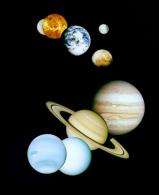Saturn, Mars and Venus line up in June sky

(PhysOrg.com) -- As darkness falls at the beginning of June, three planets will form a long line in the western sky. Saturn will be at the upper left, Mars in the middle and Venus at the lower right.
Venus will form a straight line with the bright stars Pollux and Castor of the constellation Gemini the Twins on June 11 fairly low in the west-northwest. On June 19 and 20, the brilliant white planet will pass just north of the Beehive star cluster. Binoculars will show the stars twinkling while the planet gleams steadily.
To Venus's upper left (south) will be red-orange Mars, making a colorful contrast with nearby blue-white Regulus, the brightest star of the constellation Leo the Lion. The colors will appear most vivid through binoculars. Mars and Regulus will be closest on June 6, but they will remain near each other for the first half of the month.
Saturn will materialize high in the southwest at dusk, setting around 2 a.m. local time at the start of the month and by midnight at month's end. Saturn's rings will appear to open slightly this month as seen from Earth, after being tilted nearly edgewise in late May. Mars and Venus will close in on Saturn from the lower right (west) as the month advances.
While Saturn is setting in the west, Jupiter will be rising in the east. Jupiter is a favorite target of observers with telescopes, because its rapid rotation causes its features to change position noticeably in as little as 10 minutes. Its four largest moons -- Io, Europa, Ganymede and Callisto -- will be visible in binoculars or any telescope, changing positions from night to night as they patrol east and west of the planet in their orbits. Occasionally one or more of them will disappear as they pass in front of Jupiter or behind it. These moons are bright enough that you could see them without optical aid if it weren't for Jupiter's brilliance. The planet will climb higher in the southeast during June, and views of it will improve quickly.
Mercury will be close to the eastern horizon a half hour before sunrise in early June, difficult to find in the bright sky of dawn.
Viewing information and graphics for the planets are available at www.space.com/nightsky .
Lunar eclipse
On June 26, people in much of North America will see a partial lunar eclipse. Those in the western half of the continent will have a better view, with about half of the full moon covered by Earth's shadow at the maximum point (4:38 a.m. PDT in a brightening sky). Observers in Australia and New Zealand will see the partial eclipse from beginning to end.
Meteor shower
The Bootid meteor shower will peak on the night of June 23-24, when Earth will pass through part of the debris trail of the comet that caused the meteor shower. Meteors will appear to be coming from a point in the constellation Bootes (pronounced bo OH teez) the Herdsman, which is visible in the northern sky nearly all night and contains the bright orange star Arcturus. The moon will be nearly full, so viewing will be hampered. The International Meteor Organization provides more information at www.imo.net/calendar/2010#jbo .
Solstice
The sun will reach the June solstice on June 21 at 7:28 a.m. EDT (11:28 Universal Time), marking the start of summer in the Northern Hemisphere and winter in the Southern Hemisphere. For the next six months in the Northern Hemisphere the days will be getting shorter.
The word "solstice" is derived from two Latin words that mean "cause the sun to stand still." This is because the summer sun climbs to a higher point in the southern sky each day until the solstice. On the day of the solstice it appears to arrive at about the same maximum height above the horizon as the day before, and each day afterward its maximum point is lower, dropping back toward its lowest point at the winter solstice. In this sense, the sun "stands still" at the peak of its journey across the summer sky before it starts downward again toward the southern horizon.
Moon phases
The moon will be at third quarter on June 4, new on June 12, at first quarter on June 19 and full on June 26.
Provided by Indiana University





















